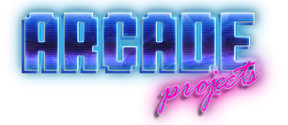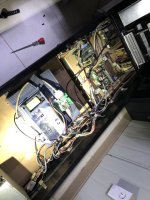This guide is for those who have heard about Net-Booting and want to know what to buy and how to make it work. As with anything there are risks involved and I take no responsibility so precede at your own risk.
If any information here is found to be in error, or if pertinent information is missing, please let me know and I will do my best to correct it. Thank you 
If you have questions DO NOT PM ME. Please post a reply in this thread, so that others with similar questions may benefit from the answer.
What is Net-Booting?
The NAOMI arcade console (and later the NAOMI 2, Tri-Force and Chihiro arcade consoles) allows for the swapping of games by swapping out the cartridge similar to home console. Part way through the NAOMI's life Sega added the option to load software onto the console from a PC connected to it through a local area network. This requires the use of a special cartridge called a "Net-DIMM" board that plugs in like a normal cartridge but includes an Ethernet port for communication with the PC. Eventually arcade hackers leveraged this, allowing us to load up most games on these systems using this mechanism as opposed to using the original cartridges or discs. When we load a game over the network using a Net-DIMM board it's called "Net-Booting".
What is Pi-Force Tools?
There is an official piece of software made by Sega for net-booting (known as transfergame.exe), however an open source alternative was made for the Tri-Force hardware using Python, originally named "Tri-Force-Tools". Despite originally designed for the Tri-Force it works for other Net-DIMM compatible consoles. Since the software doesn't need a powerful computer, and using this system with a PC is rather cumbersome, some clever individuals had the idea to use a cheap Raspberry Pi computer for the task. "Pi-Force-Tools" is a blending of the original Tri-Force-Tools software name with the Raspberry Pi hardware name. There are other versions out there as well such as the NAO-Pi which is a blending of NAOMI and Raspberry Pi. But for this guide we'll be specifically covering Pi-Force Tools.
What Games are compatible?
Not all games are compatible, but the vast majority are. The NAOMI and NAOMI 2 supported game list is fairly substantial. T
his chart lists the games that are available for Net-Boot as well as which games support hot-switching between games, which games will work with witch I/O boards and which games will work with which BIOS region.
At the time of this posting Tri-Force and Chihiro can Net-Boot the following:
Tri-Force: F-Zero AX, Mario Kart Arcade GP, Mario Kart Arcade GP 2, Virtua Striker 2002, Virtua Striker 4 v2006
Chihiro: Crazy Taxi High Roller, Ghost Squad, Gundam Battle Operating Simulator, Ollie King, Out Run 2, Out Run 2 SP Special Tours, Sega Golf Club Version 2006, The House Of The Dead 3, Virtua Cop 3, Wangan Midnight - Maximum Tune, Wangan Midnight - Maximum Tune 2
There is a dedicated game thread here:
Games Fixed to work with DIMM
What do you need to make it work?
1.
A working NAOMI, NAOMI2, Tri-Force or Chihiro setup.
This includes the arcade console board, a compatible JVS I/O board, and a JVS power supply. Note: If you're using a Capcom I/O board to provide power from a normal Arcade PSU you will need to upgrade to a JVS PSU that can connect directly to the game board. The Capcom I/O can't pass through enough power to run both the Game Board and the Net-Dimm board otherwise. Best case it wont boot, worst case it will boot and overload/blow-out your I/O board.
2.
A Compatible Net-DIMM board
Not necessary if you've got a Chihiro Type 3 or a Tri-Force Type 3 with a gd-rom port as this board is built in already. Otherwise, there are some variations you need to be aware of before buying.
Variations: Net-DIMM boards are not to be confused with a "regular" DIMM board which lacks the Ethernet port and cannot Net-Boot games. Reguar DIMM boards are a lot more common and lot cheaper so make sure you verify it has an Ethernet port before you buy it.
Memory: You will also need to make sure it has enough Memory to support your games. Most will have 256MB which will cover all but 5 games for NAOMI and NAOMI 2 (see the aforementioned chart). For those 5 games as well as Tri-Force and Chihiro you will need a 512MB Net-DIMM. I believe there is only 1 game on Chihiro that requires 1GB. Official Sega DIMM boards that have more memory will typically have an oval sticker stating "512MB" or "1GB". Smaller capacity boards can be upgraded. It uses regular PC style Memory DIMMs (hence why it's called a DIMM board).
Which can be upgraded[.1093/url].
Firmware: I should note that your Net-DIMM needs to have firmware revision 3.03 or higher to be net-boot compatible. I don't believe any Net-DIMM board shipped with firmware below 3.03 anyway so it's a moot point. However it doesn't hurt to upgrade to a newer revision. Upgrades can be performed over an eithernet connection the same way you'd load a game. 4.01 is the highest official release which added support for the official Sega Compat-Flash adapter. 4.02 is an unofficial hacked release that added support for un-official Compact-Flash adapters. There are other higher numbered hacked releases as well. FWIW I'm running 3.17 on one of my NAOMI2 Net-Boot setups without any problems.
3. A Compatible BIOS
All BIOS revisions for the Tri-Force and Chihiro should allow for Net-Booting. On the NAOMI I believe you need BIOS Rev F or later and on the NAOMI2 you'll need Rev A or later. However I recommend using the latest Muli-BIOS. That would be Rev H for NAOMI and Rev C for NAOMI2 you can get that [url='http://forum.arcadeotaku.com/viewtopic.php?t=29558']here. If you don't have the means to program your own BIOS ROM you can usually find them for sale for a reasonable price in the usual places. The multi-bios also allows for region switching using the DIP switches on the NAOMI's filterboard, which is a very handy feature to have.
4.
A Compatible Raspberry Pi
At the time of this writing, Pi-Force-Tools supports R-Pi versions 1, 2 and 3 (the amount of ram and model type A or B shouldn't matter) The Pi-Zero is NOT supported.
5.
A Raspberry-Pi Compatible SD card.
The R-Pi Version 1 uses a full-sized SD card, the Versions 2 and 3 use a Micro-SD card. You'll need a minimum 4GB card to use Pi-Force-Tools, Though you'll want at good sized card if you want to fit all games on one card. The entire list of NAOMI and NAOMI2 games fit comfortably on a single 32GB You'll need to bump up to a 64GB if you want to include Chihiro, Tri-Force and NAOMI all on one card.
The R-Pi has good compatibility with most name-brand cards but
here is a good list of tested cards.
6.
A Power Cable for the Raspberry-Pi
The R-Pi is powered by a Micro-USB port. They sell wall-wart style power adapters specifically for the R-Pi, however a much more elegant solution on a NAOMI is to cut one end off of a Micro-USB cable and crimp on a 4-pin JST NH style connector. this will allow you to power the R-Pi using the 5V pin header on the NAOMI's filter-board or on the 5V output header found on most Sega JVS I/O boards.
7.
A Cross-over Cable.
The Net-DIMM board needs to connect to the Raspberry-Pi over a valid network. Theoretically you could use a single R-Pi to net boot multiple consoles on the same network. This guide wont go into that. In the case where you'd connect the R-Pi directly to the Net-DIMM board we'll need a Cross-Over cable. Regular Ethernet cables cannot be used without a networking switch between the R-Pi and the Net-DIMM board.
8.
An Ada-Fruit "Pi-Plate" Character LCD plus keypad
Normally a R-Pi connects to a Monitor and is controlled with a keyboard or mouse via the USB ports, however Ada-Fruit makes a small plug-in module that stacks on top of the R-Pi and adds a small character LCD as well as a few buttons. It's using this simple and cheap interface that we can select which game we'd like to send to the Net-DIMM board for booting without the need for a separate monitor or a keyboard or mouse. You can
buy this on the Ada-Fruit web-store.
I should warn you that this comes UNASSEMBLED, you'll be expected to solder it together yourself. It's a very easy job to solder together. All through-hole parts with nice big solder pads. Designed for
beginners.
9.
A Zero-Key
All DIMM and Media boards have a socket on the top for a security key. Normally a official Game released on GD-ROM or Compact Flash will also include a matching security key in order to decrypt and boot the game. A Zero-Key is essentially a normal security key with an agreed upon code for use with already decrypted game ROM (such as those you'll be using for net-booting, or with a CF adapter). These are more
difficult to program yourself but not impossible. Most people who sell BIOS chips typically also sell Zero-Keys. There are two types of Zero Keys, one used by NAOMI and NAOMI2, and the other used by Tri-Force and Chihiro. There are some very specific scenarios where you can get away without using a Zero-Key but for the purposes of this guide it's best to assume you'll need one.



